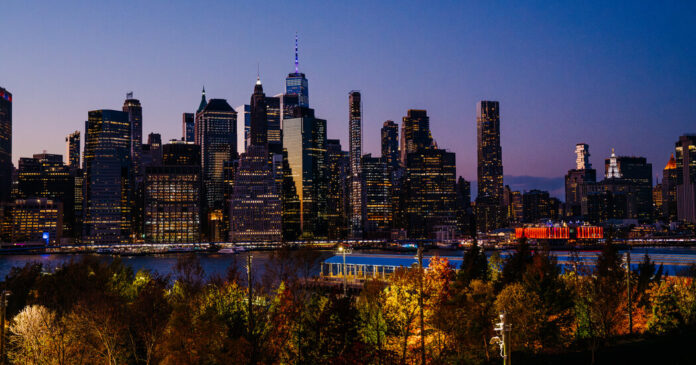Deborah Hallen first visited Brooklyn Heights as a member of an amateur chamber music group. A year later she moved there. A year later, after a performance on Staten Island, she met Paul O. Zelinsky, a children’s book illustrator who, it turned out, also lived in his art studio in Brooklyn Heights.
“I fell in love at first sight,” Ms. Hallen, 79, said of the man she soon married.
That was in the 1970s. She and Mr. Zelinsky, 70, are now grandparents but still live and work in this historic port community, home to many artists and writers. “Rents used to be affordable,” she said. “Everyone was everyone’s friend.”
Ms. Hallen accepted a position as a science teacher at the local public school, PS 8 on Hicks Street, from which she is now retired. She is vice president of the Friends of the Brooklyn Heights Branch Library, which raises money for programs at the beautiful new library at Cadman Plaza West. In addition to many book events, the library has groups for knitting, chess and other activities. Ms. Hallen also sits on Community Board 2’s Youth, Education and Cultural Affairs Committee, an appointed position. Mr. Zelinsky, who won the Caldecott Medal in 1998 and has sold millions of copies of his most popular book, “Wheels on the Bus,” is one of a circle of illustrators who meet regularly in the neighborhood.
In 1998, the couple and their two daughters left their one-bedroom apartment and moved into a two-bedroom, two-bath co-op apartment with harbor and Brooklyn Bridge views, a wood-burning fireplace and a rooftop terrace. They paid $320,000. “It’s worth over a million dollars now,” Ms. Hallen said. “We don’t feel like leaving. It’s nice and quiet here.”
She enjoys walking on the Brooklyn Heights Promenade with views of the harbor, the Brooklyn Bridge or the Manhattan Bridge, or taking the subway into Manhattan. “It’s half an hour to a Broadway show,” she said.
Brooklyn Heights has long been known as “New York’s premier suburb,” said Gerard Splendore, associate broker at Coldwell Banker Warburg, who has lived in three locations in Brooklyn Heights. He remembers “sitting next to Norman Mailer in a Chinese restaurant” in the 1980s when the writer lived and worked in the neighborhood.
“Brooklyn Heights has an amazing housing stock of post- and pre-war buildings and incredible townhouses,” said Mr. Splendore. And the recently renovated Brooklyn Bridge Park, he added, “is a huge addition to the waterfront area, with soccer, swimming, basketball, dining and kayaking.”
Residents in the area include Doc Dean, 38, managing director of Citibank’s corporate investment banking division. He and his wife Amie Dean, 44, a retired fashion industry executive, were among the first to move into the Quay condo in 2020, paying about $3 million for a three-bedroom, three-bathroom apartment. The couple now has a 6-year-old daughter and a 3-year-old son.
“We wanted to be close to my work and the neighborhood is great,” Mr. Dean said. His commute involves taking the ferry from Pier 6, just steps from his apartment, to Lower Manhattan for “a few minutes,” then walking for 15 to 20 minutes. His son plays soccer at Pier 5 and his daughter roller skates at Pier 2, attends PS 8 and also takes chess and art lessons there after school.
The couple is thrilled to be close to many great restaurants, he said: “Charlie Mitchell, the first black Michelin-starred chef in New York City, has his restaurant Clover Hill right behind us. It is great.”
Tom and Kate Gunton, both 33, have lived on Hicks Street for five years, first in a one-bedroom apartment and then in a two-bedroom, one-and-a-half-bathroom apartment in the same building, where they now earn about $3,000 a month and live with their 5-month-old daughter and an 85-pound yellow Labrador.
When they met, Ms. Gunton, who works in health care, lived on the Lower East Side; Mr. Gunton, who works at Salesforce, a software company, was living abroad. They considered staying in the Lower East Side, but wanted “a little more space and more amenities,” Mr. Gunton said, such as an elevator and laundry facilities in the building. They also wanted to be near the Brooklyn-Queens Expressway, which runs below the boardwalk, because Ms. Gunton drives to work and provides easy access for visits to his family on Long Island and her family in Pennsylvania.
Ms. Gunton takes her daughter to the boardwalk “at least once a day,” she said. “It’s like our backyard.” She’s also part of an online neighborhood chat group for new moms who give each other tips and “swap baby stuff.” Mr. Gunton plays soccer in an intramural league at Pier 5 and takes his dog to a dog park near Pier 6 or another in Cadman Plaza Park.
“This is not a temporary neighborhood,” he said. “People want to stay forever.”
What you will find
Robert A. Levine, a developer who used his initials as the name for his company RAL, remembers driving past the decaying piers and sheds along the Brooklyn Heights waterfront for many years. “They yelled at me,” he said, but no one was able to develop what he saw as a “hidden gem.”
Around 2003, he said, “things started to sink in,” and he began working with the city and state to build or convert a few new residential buildings – mostly luxury buildings, but some affordable – that would provide some of the funds for the redevelopment of the building would contribute pillars that have made Brooklyn Bridge Park a vibrant recreational area. Construction of the park began in 2008, and the nonprofit Brooklyn Bridge Park Conservancy now organizes the region’s extensive programs.
The new building represents a small portion of the neighborhood’s total area. The northern border of the community is Old Fulton Street. its southern border is Atlantic Avenue. To the east, Cadman Plaza West curves, and then Court Street takes over for a short distance. Overlooking the park and the East River to the west is the Promenade, a popular public space that describes the Heights portion of the neighborhood’s name. Dumbo is to the north, Cobble Hill to the south and Downtown Brooklyn to the east. The Brooklyn-Queens Expressway runs under the boardwalk. (The expressway’s cantilevered construction has been a concern in recent years, with proposals for short- and long-term repairs unresolved.)
Many streets are lined with leafy trees, pretty townhouses, beautiful churches and other stately buildings, thanks to a historic designation in 1965 for almost the entire neighborhood – New York City’s first such designation. The 1987 film “Moonstruck” and several others were filmed there. Many houses were built in the 19th century and most of the buildings are low-rise buildings.
“Some people see it as a middle ground between suburbia and New York City,” said Ravi Kantha, an associate broker at Leslie J. Garfield.
Montague Street is the main commercial center.
What you will pay
The average price of the 221 homes sold through September this year was $1.19 million, said John Walkup, founder of UrbanDigs, a real estate data analytics company. That was roughly in line with the average sales price of $1.2 million during the same period in 2020, when about the same number of homes sold.
But in the early years of the pandemic, when people wanted more space than Manhattan could provide, “we were on the run,” Mr. Walkup said. In 2021, sales more than doubled, to 485, with an average price of $1.45 million; in 2022 there were 408 sales at an average price of $1.3 million.
Since then, the market has slowed, partly due to higher interest rates. As of mid-November, there were 126 homes for sale on StreetEasy, ranging from a one-bedroom, one-bath co-op on the third floor of a 1950 elevator building at 100 Remsen Street listed for $370,000 to a three-family brownstone 1899 at 126 Pierrepont Street, listed for $15 million. There were about 130 rentals available, ranging from a studio in a walk-up building on State Street listed for $2,195 a month to a five-bedroom, five-and-a-half-bath townhouse on Remsen Street listed for $27,500 US dollars per month is offered.
The atmosphere
“Community members care deeply about their history,” said Lara Birnback, executive director of the Brooklyn Heights Association. “But at the same time, this is a very vibrant and thriving community.”
She added: “People are excited that our main street, Montague, has a new energy,” with new restaurants, bakeries and other shops – some of which, such as bookstore Books Are Magic and bakery L’Appartement 4F, were won over by Der Club opens on Montague Street. The group also played a role in attracting Poppy’s, a coffee shop on Henry Street, and Inga’s Bar, which was named to the NYT Critic’s Picks in May 2022.
The schools
PS 8 The Emily Warren Roebling School at 37 Hicks Street is the only public school in Brooklyn Heights. It serves students in kindergarten through fifth grade and had an enrollment of 575 in the 2021–22 school year. In 2018–19 (the last year for which ratings are available due to the pandemic), the school was still known as Robert Fulton School and included seventh and eighth grades, 76 percent of students met state standards on the English test, compared to 47 percent citywide, and 71 percent met state standards in math, compared to 46 percent citywide.
In fall 2019, sixth through eighth grade students were moved to a school in downtown Brooklyn called Bridges MS 915.
Brooklyn Heights is also home to several highly rated private schools, including St. Ann’s School, Packer Collegiate Institute, and Brooklyn Heights Montessori School.
The commute
Subway lines 2, 3, 4, 5, A, C and R all pass through the district. Ferries take people to Manhattan, and many bike—or walk—across the Brooklyn Bridge.
The history
Founded in 1910, the Brooklyn Heights Association is the city’s oldest neighborhood association, according to its website. In 1935, the group’s efforts led to the creation of Cadman Plaza Park on the site where the city had demolished the elevated tracks and transit station at the foot of the Brooklyn Bridge. In 1945, the association rejected a proposed route for the Brooklyn-Queens Expressway that would have run through the middle of the neighborhood; Instead, a triple cantilevered building was constructed on the edge of Brooklyn Heights, crowned by the now popular Brooklyn Heights Promenade. In 1960, the association was once again at the forefront, helping to thwart Robert Moses’ urban renewal plan to build luxury one-bedroom apartments at Cadman Plaza. Instead, narrower buildings and affordable family-sized co-ops took their place.
For weekly email updates on residential real estate news, sign up here.


















